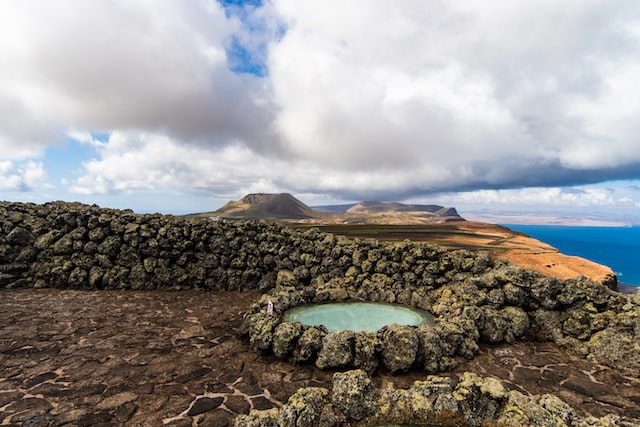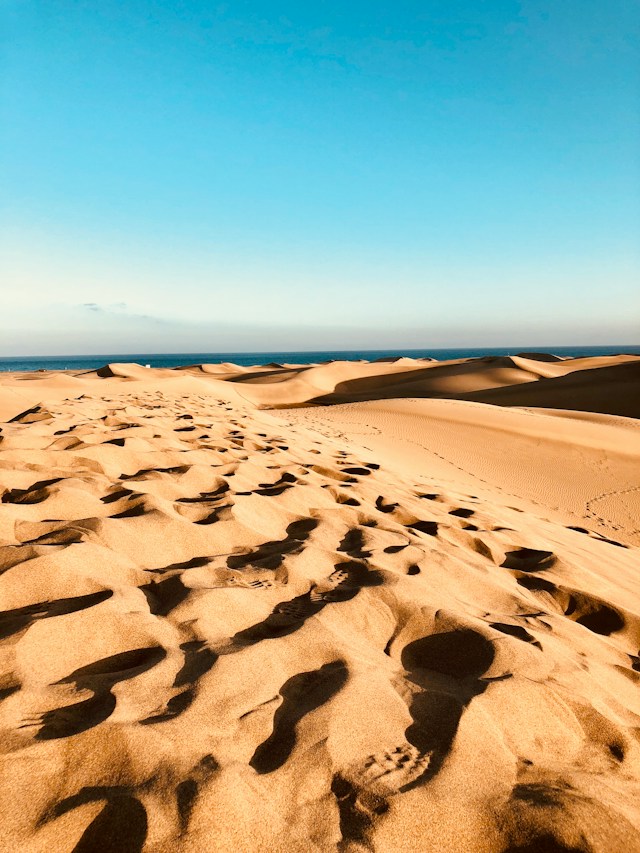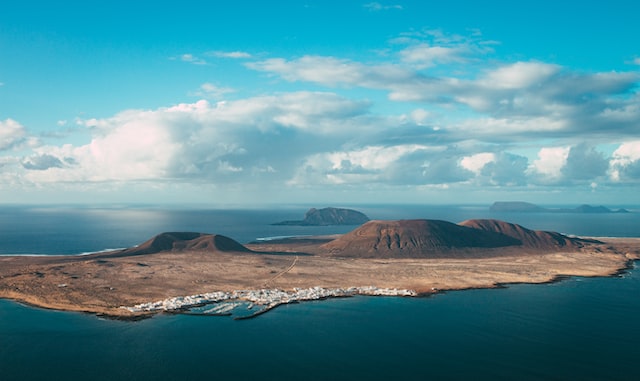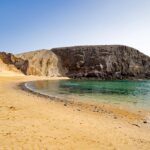If you are going to the Canaries, you should know what the climate is like in Lanzarote and Gran Canaria. In general, the Lanzarote weather is friendly all year long, the summers are hot, and the winters are exceptionally nice. Keep reading and start planning your holidays.
How is the climate in Lanzarote?
In general, the temperature in Lanzarote and in the other Canaries islands is very pleasant all year long, the climate in like spring time most of the year. It means it is not so hot in summer and not so cold in winter.
The average temperature is 22 °C. At night, the temperature can drop to 13 °C in winter and rise to 20 °C in summer, never too cold or too hot. During the day, the temperature in winter averages around 21 °C and in summer around 29 °C.
In Lanzarote, the rain is not so common, and they happen mainly in the winter months.
Also, the water temperature is stable throughout the year, between 18 and 20 °C, so you will enjoy the beach no matter which month you go there.
What type of climate does Lanzarote have?
Lanzarote has a hot desert climate, characterized by low rainfall and consistent temperatures. The Canaries island are very close to the Sahara desert, but the climate is not typical from the desert, because of the cold sea currents from the Mexican Gulf. Also, in Lanzarote, there are no mountainous masses.
All these factors combine to give Lanzarote a dry yet somewhat humid climcate.
In general, the climate in Lanzarote is:
- Hot summers: Consistently warm, with high temperatures and plenty of sunshine.
- Mild winters: Temperatures remain pleasant, even in the coldest months of the year.
- Low rainfall: Very little precipitation throughout the year.
- Low humidity: Creates comfortable conditions.

Seasonal Temperatures in Lanzarote Island
Lanzarote enjoys a pleasant climate year-round, with warm temperatures and plenty of sunshine every day.
- Summer (June-September): This is the hottest season, with average highs ranging from 25 °C to 27 °C. It’s ideal for sunbathing, swimming, and enjoying outdoor activities.
- Winter (December-February): Even in winter, temperatures remain mild in Lanzarote, with average highs around 20 °C. It’s a great time to escape the cold and enjoy some winter sun.
Rainfall and Humidity
Lanzarote is known for its dry climate, with very little rainfall throughout the year. Most precipitation occurs between December and February. Humidity levels are generally low, making for comfortable conditions.
Sea Temperatures
The water temperature in Lanzarote beaches is consistently warm, making it perfect for swimming and water sports year-round.
- Winter: Pleasant swimming conditions are ensured by the sea temperature rarely dropping below 18 C in winter.
- Summer: Sea temperatures typically range from 22 °C to 23 °C.
What is the coldest month in Lanzarote?
The coldest month in Lanzarote is January. In this month, the maximum temperature can be 22 °C and the minimum 13 °C. While December and February are cold months, and the temperature of the water can go down to 18 °C.
In the colder months, there are less sun hours in Lanzarote, which can vary from 7 to 8.
The climate in Lanzarote is pleasant all year round, even in winter. In these months, although there may be rain, it is punctual in areas of the island. In general, there is no great rainfall.
Even in winter, it is never very cold, but you might need a coat if you go in January and February, mainly at night.
Is Lanzarote hot all year?
The climate in Lanzarote is not hot all year long, but it is warm. There can be some cool days during winter, between December and March, but never too cold. For example, the cold record is 7.5 °C, recorded in February 2018.
In the hotter days, there can be winds from Africa that can decrease visibility because of the dust and sand from the desert.
The hottest months in Lanzarote are the summer ones, but the temperature won’t go further than 30 °C, and the minimum is around 20. This means that even in the summer, there is not too hot or uncomfortable.
Is Lanzarote warm all year?
The Lanzarote island, the most north-eastern of the Canaries, has a good temperate and desert climate, with mild or pleasantly warm winters, and hot, sunny summers.
The island is constantly influenced by trade winds blowing from the northeast, especially in the afternoon. These winds not only shape the island’s climate but also generate impressive waves, perfect for some water sports like surf and windsurf.
In general, the weather in Lanzarote is mild. There are many sun hours and little rain, so it is like spring all year long.
How is the climate in Gran Canaria?
Similarly to Lanzarote, Gran Canaria offers its own unique weather charms. On the island of round shape, the climate is subtropical and oceanic, which means it is mild and sunny almost every day of the year. The winter is mild, more like a spring.
There is not so much rain, the wet period is between October and March. And the trade winds are the most common.
The island can have different climates depending on the altitude.
The temperature in Gran Canaria is around the average, in January can be 18 °C, and on August 25. On the winter months, the maximum can be 17 or 17 °C, and the minimum 10 to 11 °C on the nights.

What is the best month to visit Lanzarote?
As you may have already noticed, the climate of all the Canary Islands remains almost the same all year. The temperatures are pleasant even in the winter.
This is why in December, January and February, which are the winter months, tourists flock to the island fleeing the cold, here they find sunny weather. Which makes it a good idea to go to Lanzarote in winter, even though there might be crowded.
Keep in mind that in the busiest months, such as summer and Christmas, as well as Easter, there may be lots of people on the island. This means you must book routes and excursions in Lanzarote in advance. Also, hotels can be more expensive.
We can tell you the best time to travel to Lanzarote would be between April, May, and June. These are the spring months, and in September, and October, which would be between summer and autumn. On these days, you will have many hours of sun, therefore, you could spend more time walking or on the beach. The weather will be nice.
Also, in these months, the season is low. So you might find fewer tourists and lower costs in hotels. This means you will save money when you stay in Lanzarote.
And if you have to define the best month, it could be September. Because it’s low season and the weather is perfect for getting to know the island.
Microclimates in Lanzarote and Gran Canaria
On these islands we find the distinctiveness that there are some microclimates, thanks to the mountainous relief and its geographical location.
Coastal areas vs. interiors
On the coast of Lanzarote there are warm and dry microclimates, in areas like Costa Teguise, Playa Blanca; in Puerto del Carmen it is moderate and humid. In addition to protected microclimates such as the Geria Valley and the Marble Coast. While in the interior is the Timanfaya National Park with its own microclimate.
As for Gran Canaria, in the coastal areas there are warm and dry microclimates in Maspalomas; temperate in Puerto de Mogán and Agaete and protected microclimates in Costa de los Pueblos and Costa de los Gigantes. In inland areas there is the Tamadaba Natural Park, where there is a warm microclimate and in the Tejera Valley, a temperate one.
Seasonal variations
Due to the existence of microclimates, it is possible that there are some variations in climate between some places and others within the same island.
For example, in Gran Canaria the coastal areas have sunny and dry climates, but at higher altitudes the temperatures decrease and the climate is milder. And, on the other hand, in Lanzarote the effect of the proximity to the sea and the presence of the trade winds means that there is a temperate climate, but there are also arid and dry areas in the interior.
Comparison of the climate in Lanzarote and Gran Canaria
Key Similarities and Differences
Both Lanzarote and Gran Canaria have a subtropical desert climate, in which mild, stable and pleasant temperatures predominate throughout the year. Both receive an almost equal number of hours of sunshine per year.
Temperature Differences
Despite these similarities, in Lanzarote the average annual temperature ranges between 21 and 28 degrees Celsius, while in Gran Canaria between 18 and 21. So, Lanzarote is generally warmer, specially in summer, Gran Canaria experiences more variation, with cooler temperatures in the north.
Rainfall and Humidity Comparison
As for rainfall, in Lanzarote it rains 150 millimetres per year, generally drier. While in Gran Canaria, more than double that, 350 millimetres, this island receives more rainfall, particularly in the north.
In the case of humidity, in Gran Canaria it is a little higher than in Lanzarote.
Overall, Lanzarote offers a more consistent, hot and dry climate, while Gran Canaria provides a more diverse climate with cooler areas and occasional rain.
Recommended activities depending on the weather
The climate of Lanzarote and Gran Canaria makes both places a perfect destination for outdoor activities and sports year-round. But some times are better than others depending on your preferences:
Best Activities During Summer
Although there are good temperatures throughout the year, in Gran Canaria, for example, the warmest months without rain are from June to September, perfect for the beach and water sports, but if you like cooler temperatures.
In Lanzarote, from June to September (summer) is ideal for a day at the beach or for sports such as surfing or diving. Also for enjoying the nightlife.
Best Activities During Autumn
May, October, and November are a good option for hiking, cycling, and even for going to the beaches. Also in winter you can do this activities.
This months you will enjoy cooler temperatures. If you like hiking, you can choose to travel to the island in spring or autumn, when temperatures are milder and rain will not interrupt your walks.
Tips to enjoy the island climate
- Pick the appropriate season according to the activities and places you want to practice and visit.
- Wear appropriate clothing and footwear, as well as sun protection for your skin.
- During your trip, you must remember to drink enough water.
- Find out about the norms and rules of each place you want to visit, so as not to affect the environment.
- Remember to check the specific weather forecast before your trip and pack accordingly.
Conclusion
In conclusion, the Canary Islands, like Lanzarote and Gran Canaria, offer a delightful escape with their near-perfect climate throughout the year.
Lanzarote, with its gentle, desert-like weather, promises warm winters and comfortably hot summers, making it an ideal destination for those seeking a break from more extreme climates. On the other hand, Gran Canaria, embracing its subtropical character, ensures mild and sunny conditions, perfect for a variety of outdoor activities.
So, whether you choose the mild winter months for a sunny retreat or the warm summer for a lively holiday, Lanzarote and Gran Canaria stand ready to offer you a memorable getaway. Remember, planning is key, so consider booking your activities, transfer from lanzarote airport to Playa Blanca and accommodations in advance, especially during peak seasons.
With this guide to the climate in Lanzarote and Gran Canaria, you’re now equipped to choose the best time for your visit, ensuring a trip that aligns perfectly with your travel preferences.
Our company seeks to deliver the best service you can find on the island today. We seek to optimise our clients’ time and resources, which is why we respect the schedules and offer the best prices for different transfers.









One comment